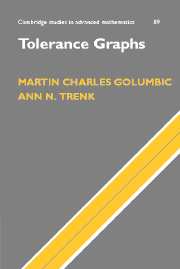Book contents
- Frontmatter
- Contents
- Chapter Dependencies
- Preface
- 1 Introduction
- 2 Early work on tolerance graphs
- 3 Trees, cotrees and bipartite graphs
- 4 Interval probe graphs and sandwich problems
- 5 Bitolerance and the ordered sets perspective
- 6 Unit and 50% tolerance orders
- 7 Comparability invariance results
- 8 Recognition of bounded bitolerance orders and trapezoid graphs
- 9 Algorithms on tolerance graphs
- 10 The hierarchy of classes of bounded bitolerance orders
- 11 Tolerance models of paths and subtrees of a tree
- 12 φ-tolerance graphs
- 13 Directed tolerance graphs
- 14 Open questions and further directions of research
- References
- Index of Symbols
- Index
11 - Tolerance models of paths and subtrees of a tree
Published online by Cambridge University Press: 11 August 2009
- Frontmatter
- Contents
- Chapter Dependencies
- Preface
- 1 Introduction
- 2 Early work on tolerance graphs
- 3 Trees, cotrees and bipartite graphs
- 4 Interval probe graphs and sandwich problems
- 5 Bitolerance and the ordered sets perspective
- 6 Unit and 50% tolerance orders
- 7 Comparability invariance results
- 8 Recognition of bounded bitolerance orders and trapezoid graphs
- 9 Algorithms on tolerance graphs
- 10 The hierarchy of classes of bounded bitolerance orders
- 11 Tolerance models of paths and subtrees of a tree
- 12 φ-tolerance graphs
- 13 Directed tolerance graphs
- 14 Open questions and further directions of research
- References
- Index of Symbols
- Index
Summary
Introduction
We began this book by introducing the class of tolerance graphs, which generalize the intersection graphs of intervals on the line (interval graphs), adding an edge between two vertices in the tolerance graph when the size of the intersection of their intervals exceeds at least one of the tolerances. Subsequently, we studied a further generalization defined by allowing separate right and left tolerances on the intervals (bitolerance graphs).
In this chapter, we present a totally different approach to generalizing tolerance graphs by replacing the real line by a tree and replacing the role of intervals by either paths or other types of subtree. Several classical results are known for classes of intersection graphs of paths and subtrees of a tree, which we review in the next three sections. We then present results on tolerance versions.
Intersection models
Let T be a tree and let T = {Ti} be a collection of subtrees (connected subgraphs) of T. We may think of the host tree T either as a continuous model of a tree embedded in the plane, thus generalizing the real line from the one dimensional case, or as a finite discrete model of a tree, namely, a connected graph of vertices and edges having no cycles, thus generalizing the path Pk from the one-dimensional case. Making a distinction between these two models will become important when we measure the size of the intersection of two subtrees.
- Type
- Chapter
- Information
- Tolerance Graphs , pp. 164 - 192Publisher: Cambridge University PressPrint publication year: 2004



